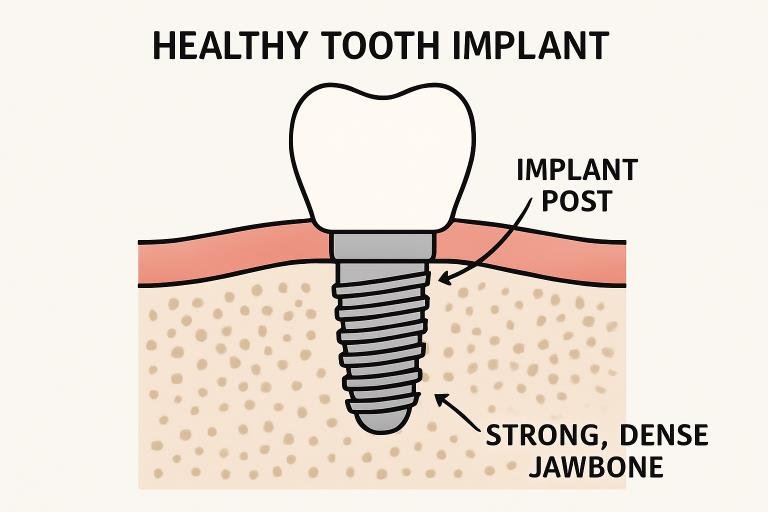Healthy bone structure plays a vital role in the long-term success of implant-based tooth replacement. When an implant is placed, it relies on the surrounding jawbone to anchor securely and integrate through a natural process known as osseointegration. Without adequate bone density and volume, implants may not achieve the stability needed to support normal chewing and daily function. This makes bone health a foundational factor in determining candidacy for such treatments.
In many cases, bone loss can result from periodontal disease, aging, or extended periods without a tooth in place. Addressing these issues through preventive care or bone grafting can improve outcomes and extend the life of an implant. Those considering options like dental implants Louisville KY, should understand the link between bone quality and implant stability to make more informed choices.
Understanding Osseointegration
Osseointegration is crucial for effective dental implants, as living bone cells attach and grow onto the implant, forming a stable connection without scarring. This process enables the implant to handle chewing forces and withstand daily oral activities, resulting in predictable outcomes, less movement, and increased comfort. The success of osseointegration relies on bone health, surgical technique, and implant surface design. Dentists track progress during follow-up visits, making adjustments to treatment as needed to ensure proper bone-to-implant contact and minimize risks such as implant mobility or early failure.
Bone Density: A Key Player
Assessing bone density is key when evaluating patients for dental implants. This process measures the amount of minerals in the bone, particularly calcium and phosphorus, which impacts how stable the implant will be. Bones with higher density provide a stronger anchor, resist stress, and reduce the risk of complications during healing, such as micromotion. Studies have found that patients with higher bone density are more likely to have successful implant integration. By accurately assessing bone density, dentists can choose the right implant and place it correctly, which increases the chances of a successful osseointegration and longer-lasting restoration.
Impact of Bone Quality on Implant Outcomes
Bone quality involves more than density, including mineral composition, trabecular structure, and tissue health. High-quality bone promotes faster healing and better osseointegration. At the same time, poor quality—common in older adults or those with diseases—can hinder healing and increase risks like implant instability or failure. Pre-implant evaluations analyze bone density, structure, and vascular health, identifying issues such as osteoporosis or inadequate bone width. This helps tailor treatments, potentially involving bone grafting or guided regeneration to ensure optimal implant success.
Assessing Bone Health Before Implantation
A thorough assessment of bone health is vital for successful dental implants. Modern tools like panoramic X-rays and 3D CT scans provide detailed views of bone volume, density, shape, and landmarks. They help identify defects, assess bone quality, and plan implant placement accurately. This process also reveals hidden issues such as bone loss, cysts, or infections that must be addressed beforehand. With this information, dental teams can tailor implant choices to each patient, reducing complications and improving long-term success.
Enhancing Bone Health for Better Implant Stability
Several practical steps exist for patients to improve bone health and enhance implant integration. Nutrition is key: eating calcium-rich foods like dairy, leafy greens, and fortified items provides essential materials for bone repair. Combining calcium with vitamin D—from sunlight, fish, or supplements—maximizes absorption. Regular weight-bearing exercise like walking, jogging, or resistance training supports cardiovascular health and stimulates bone remodeling, maintaining or increasing bone mass.
Lifestyle factors are equally vital. Quitting smoking is crucial, as it constricts blood vessels, reduces oxygen, and impairs bone healing and tissue recovery. For those with insufficient bone, regenerative procedures such as grafts, sinus lifts, or biomaterials can strengthen deficient areas for better implant success. Maintaining good oral hygiene and regular check-ups promotes a healthy environment for long-term implants.
Monitoring Implant Stability
After a dental implant is surgically placed, a crucial healing window begins, during which the quality of osseointegration must be monitored to ensure optimal outcomes. Dentists employ advanced technology such as resonance frequency analysis (RFA) to measure the implant stability quotient (ISQ), providing objective, reproducible data on how well the implant interacts with the surrounding bone. Typically, ISQ values are tracked over several months, offering clinicians real-time feedback to guide post-operative care and identify early warning signs of complications.
Consistently high or rising ISQ readings indicate robust integration, while unexpectedly low or dropping ISQ values may prompt clinicians to modify treatment or introduce bone-supporting interventions. As the American Academy of Implant Dentistry highlighted, routine stability checks during follow-up visits are indispensable for detecting and addressing minor issues before they escalate into significant problems. This vigilant approach—combining high-tech monitoring with clinical expertise—helps safeguard the investment in dental implants and assures patients of lasting benefits.
Conclusion
The health and integrity of the jawbone are inseparably connected to the stability and longevity of dental implants. By prioritizing comprehensive assessment, adopting healthy lifestyle and nutrition practices, and employing state-of-the-art monitoring technologies, patients and dental professionals can create the conditions for outstanding implant success. Recognizing and nurturing the bone-implant relationship at every phase—before, during, and long after surgery—ensures fully functional, reliable, and aesthetically pleasing dental restorations that stand the test of time. Individuals embarking on the dental implant journey should remember that investing in bone health is, ultimately, an investment in their confidence and overall well-being for years to come.



